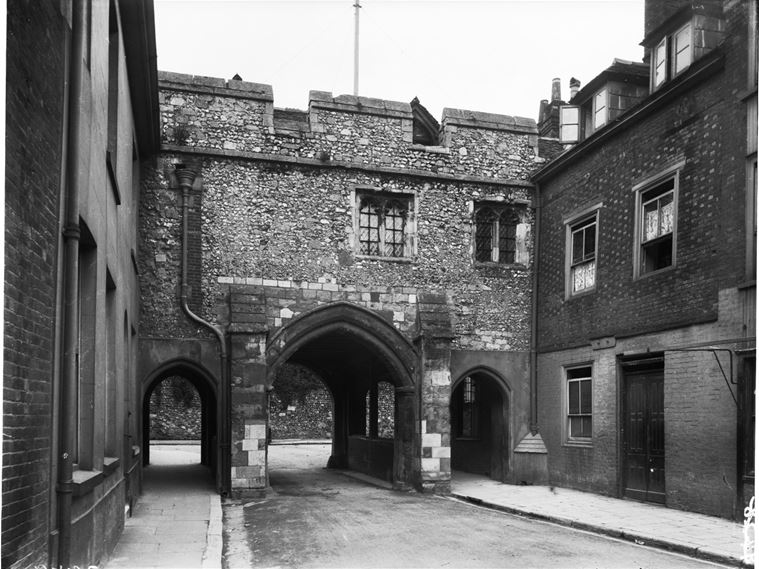Hampshire
Explore hidden histories, historic photos, and things you never knew about Hampshire from the collections and archives of Historic England.
Discover your local listed buildings and places
Introducing some of Hampshire's most historic sites, included in the National Heritage List for England. Some of these captions have been summarised by AI. Click through for the official List entry. Skip this section and go to place by numbers
Hackwood Park
Old Basing and Lychpit
Hackwood Park is an 18th-century ornamental woodland designed by Charles Bridgeman and James Gibbs, featuring historical landscapes and gardens, evolving since medieval times under various...
Allbrook Farmhouse
Allbrook
Former farmhouse, later house. Built in 1659, the south elevation refronted and refenestrated in the early to mid C19 with two storey porch added by 1892.
Fort Monckton
Gosport
The upstanding remains, earthworks and buried remains of a late-C18 bastioned artillery fort. Read the official list entry to find out more.
Rhinefield House
Brockenhurst
Rhinefield House, designed by W.H. Romaine-Walker and A.W. Tanner, is a 19th-century country house with restored gardens and notable North American arboretum in New Forest.
Herriard Park
Herriard
Herriard Park features late 17th-century gardens by George London and an 18th-century landscape by Humphry Repton. It remains privately owned, with various historic and modern structures.
Former IBM Pilot Head Office (now Lynx House)
Portsmouth
Office building, 1970-71 by Foster Associates; structural engineers Anthony Hunt.
Mountbatten House (formerly Gateway House): roof gardens …
Basingstoke
A series of roof gardens and perimeter landscaping for Gateway House (now Mountbatten House) created by Arup Associates' Group 2 and the landscape gardener James Russell for the paper...
Brockenhurst Park
Brockenhurst
Brockenhurst Park transformed from agricultural land into a picturesque estate by Edward Morant from 1770, with Italianate gardens lauded in the early 1900s.
Minley Manor
Blackwater and Hawley
Minley Manor reflects late 19th-century tastes with its French Chateau style inspired by Henry Clutton, featuring pleasure grounds and gardens designed by Robert Veitch and FW Meyer.
Hurstbourne Park
Hurstbourne Priors
Hurstbourne Park is a late 18th-century landscape park, featuring formal gardens and a 19th-century Jacobean-style mansion, historically linked to influential figures and transformed over...
Dogmersfield Park
Dogmersfield
Dogmersfield Park, a historic estate with origins in medieval times, underwent significant landscape remodeling in the 18th century, possibly by William Emes.
Royal Victoria Country Park (Formerly Royal Victoria Mili…
Hamble-le-Rice
Royal Victoria Country Park was formerly the largest military hospital, opened in 1863, designed by E O Mennie, and later became a public park after demolition in 1966.
Stratton Park
Micheldever
Stratton Park, originally laid out by Sir Francis Baring in the early 19th century, incorporates aspects of Humphry Repton's designs and features historical gardens from the late 17th...
Tylney Hall
Newnham
Tylney Hall, designed by Edward Birchall and altered by Selden Wornum, features gardens by Gertrude Jekyll and a parkland now used as a golf course.
Mountbatten House (formerly Gateway House), Basing View
Basingstoke
Former headquarters for the paper merchants Wiggins Teape built in 1974-76 to designs by Arup Associates' Group 2. Read the official list entry to find out more.
Lainston House
Sparsholt
Lainston House is a historic country house and formal garden from the 17th century, with significant ties to historical figures like John Evelyn and Gertrude Jekyll.
Rotherfield Park
Colemore and Priors Dean
Rotherfield Park is a historical estate dating back to the 12th century, featuring picturesque 19th-century gardens and architecture, and has been owned by prominent families, including the...
GRACE DIEU and the possible site of the HOLIGOST
Botley
These rare 15th-century sites are the remains of two of Henry V's four 'great ships': the Grace Dieu, one of the largest carracks (a type of wooden sailing ship) to be built but the victim...
'Whale' roadway section and buffer pontoon of the Second …
Southampton
'Whale' roadway section and buffer pontoon from a Second World War Mulberry Harbour. Built in 1943-1944 and installed next to the Royal Pier, Southampton in 1950.
The Royal Hospital, Haslar
Gosport
The Royal Hospital, Haslar, opened in 1753, was Britain's first large naval hospital, significant for its axial design and historic naval heritage.
Church of St Mary
Andover
Parish church of 1840-1846, by A F Livesay (1807-1879), with revisions and completion by Sydney Smirke (1798-1882) of 1842-1846, and refurnishing and alterations of 1871 by William White...
Cranbury Park
Hursley
Cranbury Park features 18th-century formal gardens, pleasure grounds, and a landscape park with historic buildings. Its design includes works by George Dance the Younger and J B Papworth.
Moundsmere Manor
Preston Candover
Moundsmere Manor, designed by Sir Reginald Blomfield in 1908-09, features formal gardens, walled kitchen gardens, and a pinetum, maintaining historical integrity with minor modern...
Bastion No 1, Gosport Lines
Gosport
A late C18 bastion and associated features of the Gosport Lines surviving as upstanding remains, earthworks and buried archaeological remains. Read the official list entry to find out more.
Southsea Common
Portsmouth
Southsea Common, developed from waste ground, became a 19th-century pleasure ground in Portsmouth, featuring forts, gardens, memorials, and parks, retaining historical significance through...
The King's Royal Rifle Corps War Memorial, Winchester
Winchester
War memorial. Erected 1922, after the First World War, to the design of the sculptor John Tweed with an inscription added after the Second World War.
Submarine Escape Training Tank (SETT), HMS Dolphin
Gosport
Submarine Escape Training Tank and support accommodation, designed 1950-1, operational 1954. Tower re-clad and windows altered circa 1995 (these alterations are not of special interest.).
Cadland House
Fawley
Cadland House, originally a cottage orné, was expanded by Robert Drummond with designs by Lancelot Brown and Henry Holland. It is notable for surviving historical landscape features.
Long Curtain, King's Bastion and Spur Redoubt
Portsmouth
Portsmouth's 17th-century defences, designed by Sir Bernard de Gomme, include the Long Curtain wall and the King's Bastion, with the unique Spur Redoubt enhancing its strategic strength.
Cathedral Church of the Holy Trinity
Winchester
The Cathedral Church of the Holy Trinity, built with Isle of Wight stone, features a remodelled nave and notable Perpendicular recasing, overseen by historic figures like Bishop Edington.
Embley Park
Wellow
Embley Park, a woodland and shrub garden from the 19th and early 20th centuries, was Florence Nightingale's home. The estate includes formal terraces, parkland, and modern school facilities.
Church of St Michael and All Angels
Lyndhurst
The Church of St Michael and All Angels, designed by W. White, features Pre-Raphaelite interior art, including stained-glass by Burne-Jones and paintings by Lord Leighton and J.H. Pollen.
Hilsea Lines
Portsmouth
Linear bastioned and casemated defensive fortification, built between 1858 and 1871, replacing C18 defences protecting the northern approach to Portsmouth.
Mary Rose
Spithead, off Portsmouth
The Mary Rose, Henry VIII's flagship, sank in 1545. Raised remains from 1982 and parts recovered in 2005 are displayed by the Mary Rose Trust; the rest is protected underwater.
Fort Blockhouse
Gosport
The upstanding remains, earthworks and buried remains of an early C18 bastioned artillery fort. Read the official list entry to find out more.
HMS Invincible
Horse and Dean Sand, Eastern Solent, off Portsmouth
HMS Invincible, a British Third Rate ship, stranded and capsized in 1758. Originally French, she played a crucial role in naval design history.
The Grange
Northington
The Grange, a Greek Revival country house in Hampshire, was transformed by William Wilkins in the early 19th century for Henry Drummond. It's a Scheduled Ancient Monument.
The Vyne
Sherborne St. John
The Vyne, an estate in Hampshire, evolved from a manor in the 16th century. Prominent figures, including Baron Sandys, Henry VIII’s Lord Chamberlain, influenced its historical development.
Explore more
Search for more listed placesHampshire through time
This timeline shows the first period of use for buildings and places on the National Heritage List for England, just one of the details recorded for every list entry. Click around to see how Hampshire changes over time. Skip this section and go to aerial photos
Prehistoric Before AD 43
Prehistory covers a million years of human occupation before the Roman invasion and the introduction of writing. Primarily hunter-gatherers of several human species including Neanderthals, the peoples moved across Europe, hunting animals, exchanging ideas and developing complex culture and belief systems including burial rites and astronomical understanding, as at Stonehenge for example.
Roman AD 43 to AD 410
Britain was invaded by four legions of the Roman army in AD 43, who relatively rapidly conquered England from landing points in Kent. Parts of Wales and Scotland soon followed.
Roman culture brought urbanism, monumental buildings, wide-ranging religious beliefs, writing, and strong social hierarchy. The Roman administrative system was withdrawn in AD 410.
Early medieval AD 410 to AD 1066
This period, often associated in England with Anglo-Saxons and Vikings, saw a reduction in urban living from the Roman period and increased migration from northern Europe.
Traces of this period can be found in cemeteries, particularly in artefacts and in some of the very early churches, as this period also saw the growth of Christianity in Britain.
Medieval AD 1066 to AD 1540
This period, sometimes known as the Middle Ages, began with the Norman invasion in AD 1066. It saw a significant rise in military and defensive buildings such as castles and earthworks, as well as religious houses dominating a largely agricultural landscape.
The monarchy and Church dominated the period, which also saw the break with the Roman Catholic Church and the English reformation.
Post medieval AD 1540 to AD 1901
The Post-Medieval period brought seismic changes to life in England, with religious reformation leading to the democratization of worship and the destruction of hundreds of religious houses.
In parallel, there was a huge expansion of scientific study and enlightenment that permanently altered the nation's social structure and landscape. Industrialization and mass production lead to wider global trade, emigration, and immigration.
20th century AD 1901 to AD 2000
The 20th century saw an incredible expansion of England's transport networks, with suburban growth shadowing rapid infrastructural expansion. The establishment of state schools, hospitals, and modern technical colleges, with new architectural styles, radically changed the appearance of towns and cities.
Two catastrophic world wars and the 1918 pandemic also brought unprecedented change, altering England's built environment and social structures forever.
Prehistoric Before AD 43
Prehistory covers a million years of human occupation before the Roman invasion and the introduction of writing. Primarily hunter-gatherers of several human species including Neanderthals, the peoples moved across Europe, hunting animals, exchanging ideas and developing complex culture and belief systems including burial rites and astronomical understanding, as at Stonehenge for example.
Roman AD 43 to AD 410
Britain was invaded by four legions of the Roman army in AD 43, who relatively rapidly conquered England from landing points in Kent. Parts of Wales and Scotland soon followed.
Roman culture brought urbanism, monumental buildings, wide-ranging religious beliefs, writing, and strong social hierarchy. The Roman administrative system was withdrawn in AD 410.
Early medieval AD 410 to AD 1066
This period, often associated in England with Anglo-Saxons and Vikings, saw a reduction in urban living from the Roman period and increased migration from northern Europe.
Traces of this period can be found in cemeteries, particularly in artefacts and in some of the very early churches, as this period also saw the growth of Christianity in Britain.
Medieval AD 1066 to AD 1540
This period, sometimes known as the Middle Ages, began with the Norman invasion in AD 1066. It saw a significant rise in military and defensive buildings such as castles and earthworks, as well as religious houses dominating a largely agricultural landscape.
The monarchy and Church dominated the period, which also saw the break with the Roman Catholic Church and the English reformation.
Post medieval AD 1540 to AD 1901
The Post-Medieval period brought seismic changes to life in England, with religious reformation leading to the democratization of worship and the destruction of hundreds of religious houses.
In parallel, there was a huge expansion of scientific study and enlightenment that permanently altered the nation's social structure and landscape. Industrialization and mass production lead to wider global trade, emigration, and immigration.
20th century AD 1901 to AD 2000
The 20th century saw an incredible expansion of England's transport networks, with suburban growth shadowing rapid infrastructural expansion. The establishment of state schools, hospitals, and modern technical colleges, with new architectural styles, radically changed the appearance of towns and cities.
Two catastrophic world wars and the 1918 pandemic also brought unprecedented change, altering England's built environment and social structures forever.
Aerial photos of Hampshire
Aerial photography helps reveal secrets of England's changing landscapes that are impossible to see from the ground. Skip this section and go to archive images
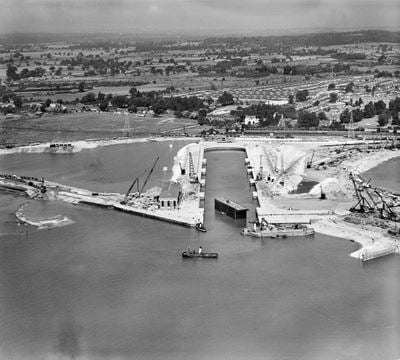
Southampton
King George V Graving Dock and environs, Southampton, 1933
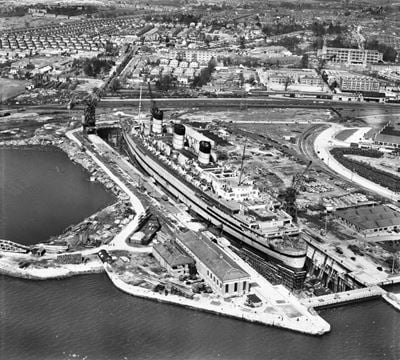
Southampton
Queen Mary in dry dock, Southampton, 1947
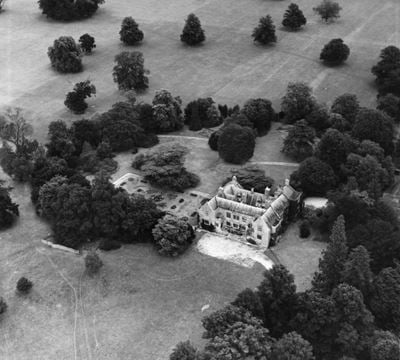
Bisterne
Bisterne Manor, Bisterne, 1949
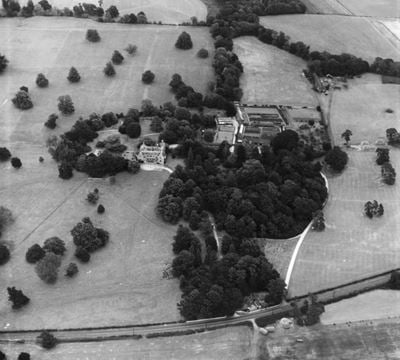
Bisterne
Bisterne Manor, Bisterne, 1949

Old Alresford
Manor Farm and nearby watercress beds, Old Alresford, 1951
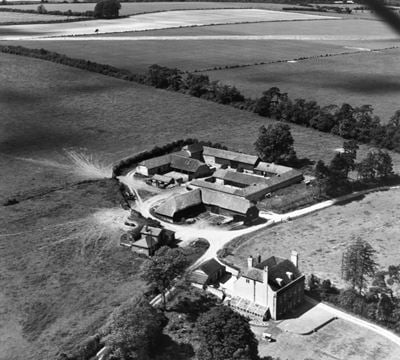
Old Alresford
Manor Farm, Old Alresford, 1951

Southampton
East Park and Above Bar Street, Southampton, 1928
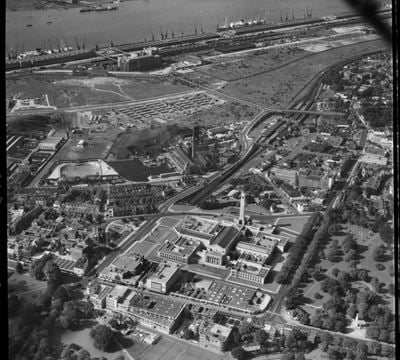
Southampton
The Civic Centre and environs, Southampton, 1957

Netley
Netley Abbey, Netley, 1928
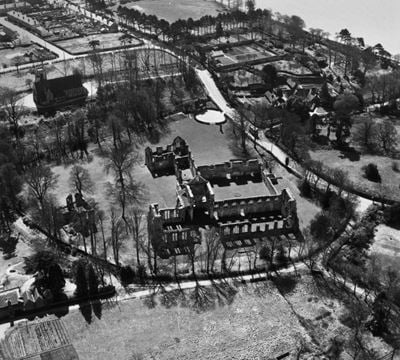
Netley
The remains of Netley Abbey, Netley, 1951
Hampshire in the Historic England Archive
The Historic England Archive cares for over 15 million images, dating from the 1850s to the present day. Discover stunning images of Hampshire's past. Skip this section and go to stories about heritage
Charles George Harper Collection
Bedhampton, Havant, Hampshire
Date created: 1892 - 1933
A view from the south of Bedhampton Mill
Eric de Mare
Portsmouth, City Of Portsmouth, City Of Portsmouth
Date created: 1956
General view of a figurehead from HMS Benbow outside Boat House number 5 at Portsmouth Naval Dockyard.
John Gay Collection: Modern Architects
Aldershot, Rushmoor, Hampshire
Date created: 1974
Looking along a louvred vent and walkway on the south-west side of the Aldershot Telephone Exchange
John Gay Collection: Rural Life
East Hampshire, Hampshire
Date created: 1950 - 1956
View of farmer E F Munday driving a tractor across a chalky field with woodland in the background
John Gay Collection: Counties
Longbridge, Basingstoke And Deane, Hampshire
Date created: 1960s
A view along the River Loddon to Longbridge Mill, a 17th century mill with early 19th century alterations.
John Laing Collection
Peel Common, Fareham, Hampshire
Date created: 30 Nov 1979
A view of reinforced concrete base slabs for humus tanks during the construction of Peel Common Sewage Works
London, Midland and Scottish Railway Company
East Hampshire, Hampshire
Date created: 1917 - 1930
A photograph of a print showing a biplane, possibly a Handley Page Type O, in a field at an unindentified location
Alfred Newton and Sons
Beaulieu, New Forest, Hampshire
Date created: 1902 - 1920
HISTORICAL GROUND PLAN
Nigel Temple Collection of Postcards of Parks and Gardens
Southsea Common, City Of Portsmouth
Date created: 1920 - 1935
GENERAL VIEW SHOWING SOUTH PARADE PIER AND GARDENS
Eric de Mare
Portsmouth, City Of Portsmouth, City Of Portsmouth
Date created: 1956
Exterior elevation of the fire station at Portsmouth Naval Dockyard. The dockyard included a 'village' for senior officials.
John Laing Collection
Peel Common, Fareham, Hampshire
Date created: 19 Jul 1978
A view of partially constructed sheet pile walls on the construction site of Peel Common Sewage Works
Nigel Temple Collection of Postcards of Parks and Gardens
Southsea Common, City Of Portsmouth
Date created: 1920 - 1935
GENERAL VIEW LOOKING TOWARDS SOUTHSEA CASTLE
Stories about heritage in your local area
Historic England publishes news, blogs, research, videos, and podcasts celebrating England's rich heritage. Discover the stories we have about Hampshire. Skip this section and go to education
What Was the Capital of England Before London?
Mentions Cathedral Church of the Holy Trinity, Winchester Cathedral Close
London is England’s capital city now, but when was it founded? And what was the capital of England before London?
10 Lesser Known Places Linked to King Henry VIII
Mentions Calshot Castle: a 16th century artillery castle
Discover the lesser-known historic sites linked to Henry VIII, including Whitehall Palace, Windsor Castle, Rievaulx Abbey, and Eltham Palace, London.
The Legend of King Arthur
Mentions Great Hall Winchester Castle
King Arthur was central to the legendary tales of medieval romance. Discover the places connected to Camelot, Tintagel, and the Battle of Badon Hill.
Battles, Castles and Ships: England’s Military History from the Air
Mentions Portchester Castle
Discover England's military history through aerial photography from the Aerofilms Collection.
Narrative Structures: England’s Literary History in 11 Places
Mentions Jane Austen's House, 8, College Street
Discover the historic sites in England where famous writers found their inspiration.
The Life and Times of King Alfred the Great
Mentions Statue of Alfred the Great
Explore the story of the Saxon King often credited with being the founder of the English nation.
12 of the Oldest Tea Rooms in England
Mentions The Thatched Cottage Restaurant
Tea rooms first appeared in England in the 18th century, and the first tea room, Twinings, has stood in the same spot for over 300 years.
A Guide to Norman Architecture in England
Mentions Cathedral Church of the Holy Trinity
Norman architecture is a style of medieval architecture built in England following the Norman conquest in 1066.
Empress Matilda and ‘The Anarchy’
Mentions Winchester Castle
A look at the career of 12th century claimant to the English throne the Empress Matilda.
13 Roman Ruins to Visit in England
Mentions The Roman Villa
Remains of Roman Britain can be found everywhere, from walls left in our cities to forts and villas in the countryside.
Hidden in Plain Sight: Evidence of the Second World War
Mentions Civil Defence Control Centre (Former Air Raid Precautions Report Centre)
Discover the evidence of how the Second World War had an impact on urban, suburban and rural England which are hidden in plain sight.
9 Places That Tell the Story of Early Flight
Mentions G1 Building at the Royal Aircraft Establishment, Memorial to Lieutenant Reginald Archibald Cammell, Air Battalion Royal Engineers
The first sustained, powered, heavier-than-air flight in the UK signalled a new age of sky-high ambitions.
Mentions Hampshire
The Rooswijk was a Dutch East India Company trading ship that sunk in January 1740 on the Goodwin Sands off the Kent coast.
What We Found on a 1740 Shipwreck: Sabres, Silver and Secrets From the Deep
The Rooswijk was a Dutch East India Company trading ship that sunk in January 1740 on the Goodwin Sands off the Kent coast.
Research Reports Roundup February 2025
Mentions Hampshire
A roundup of the latest additions to our research reports database from October 2024 to February 2025, arranged by theme.
17 Remarkable Historic Places Listed in 2024
Mentions A prehistoric round barrow, First World War practice trenches, and a Second World War Heavy Anti-Aircraft Battery on Browndown Ranges (North), Mk1 Inglis Portable Military Bridge (Light Type) over the Basingstoke Canal, Hampshire
Celebrating 17 historic gems that were examined, protected and added to the National Heritage List for England in 2024.
50 Years of Flying for Heritage
Mentions Hampshire
Learn about discoveries made in over 50 years of flying by Historic England aerial photographers and their predecessors.
Browndown: Training for Trench Warfare in the First World War
Mentions A prehistoric round barrow, First World War practice trenches, and a Second World War Heavy Anti-Aircraft Battery on Browndown Ranges (North), Hampshire
Recent survey has supported protection at one of the best preserved First World War training grounds.
Gosport: A Town Defined by its Military Heritage
Mentions Hampshire
Gosport is a place whose character is defined by its military heritage and this is underpinning the town’s Heritage Action Zone and regeneration.
The Roman Landscape Characterisation and Prediction Project
Mentions Hampshire
Harnessing the potential of existing knowledge to develop predictive models of Roman settlement.
Historic England Reveals its Heritage at Risk Register 2024
Mentions Hampshire
Historic England has today revealed its Heritage at Risk Register 2024. This is a snapshot of the health of England’s historic buildings and places.
The Guildhall, Newport, Isle of Wight
Mentions The Guildhall
Research into a civic building designed by the eminent late 18th and early 19th century architect John Nash.
Unusual Bridge Across the Basingstoke Canal Listed
Mentions Mk1 Inglis Portable Military Bridge (Light Type) over the Basingstoke Canal, Hampshire
The Inglis Pyramid Bridge near Aldershot is a rare survivor of a type of First World War portable military bridge.
The Lost Roman Road From Chichester To Arundel
Mentions Hampshire
Analysis of lidar and aerial photography leads to the rediscovery of a long-speculated route of a Roman Road.
Rare First World War Practice Trenches in Gosport Scheduled
Mentions A prehistoric round barrow, First World War practice trenches, and a Second World War Heavy Anti-Aircraft Battery on Browndown Ranges (North), Thames Block, Fort Blockhouse, Admiralty boundary stone, Fort Blockhouse
The well-preserved site at Browndown, Gosport in Hampshire has been designated as a scheduled monument.
Research Reports Roundup to February 2024
Mentions Hampshire
A roundup of new additions to the Historic England Research Reports database and a longer term overview of industrial heritage reports.
Hampshire's social history through photos
Over 10,000 images from the Historic England Archive have been specially selected and re-captioned for teachers, students, and anyone who wants to learn more about their local area. Skip this section and go to grant-aided places
Yarmouth Castle, Quay Street, Yarmouth, Isle of Wight
Period: Tudor (1485 - 1602)
Yarmouth Castle, an artillery castle, was built after the French raid on the Isle of Wight in 1545.
Yarmouth Castle, Quay Street, Yarmouth, Isle of Wight
Workmen queuing at a mobile canteen, Fawley, Hampshire
Period: 1950s (1950 - 1959)
The men in the picture were working for John Laing plc to build a reservoir for the Esso Refinery Company in September 1954.
Workmen queuing at a mobile canteen, Fawley, Hampshire
Wolvesey Castle, Winchester, Hampshire
Period: Medieval (Middle Ages) (1066 - 1484)
Wolvesey Castle was the palace of the Bishops of Winchester. It was built by the bishop Henry de Blois in c1130 - 71.
Wolvesey Castle, Winchester, Hampshire
Winchester, Hampshire
Period: Victorian (1837 - 1901)
Elevated view looking over the rooftops of Winchester from St Giles' Hill, with Winchester Cathedral in the distance.
Winchester, Hampshire
Winchester, Hampshire
Period: Victorian (1837 - 1901)
Elevated view from St Giles' Hill looking across the rooftops of Winchester towards Winchester Cathedral.
Winchester, Hampshire
Westgate, High Street, Winchester, Hampshire
Period: Medieval (Middle Ages) (1066 - 1484)
A view from the south-east looking up the High Street towards West Gate, with a horse and cart outside the shops to the right hand side.
Westgate, High Street, Winchester, Hampshire
West Gate, Southampton, Southampton
Period: Medieval (Middle Ages) (1066 - 1484)
The east face of the West Gate, with two women standing beneath the arch. The West Gate was one of the 5 main gateways in to the medieval city.
West Gate, Southampton, Southampton
West Gate, Southampton, Hampshire
Period: Medieval (Middle Ages) (1066 - 1484)
The West Gate was one of the 5 main gateways in to the medieval city.
West Gate, Southampton, Hampshire
Visit grant-aided places near you
These places and buildings have been helped by Historic England's financial grants. Find historic places in your neighbourhood that you never knew existed! Please note that opening times may vary. Skip this section and go to related locations
Fort PurbrookPeter Ashley Lane
Fort Purbrook, constructed in the late 19th century as part of a series of defensive structures along Portsdown Hill to protect the Portsmouth naval...
E Magazine, Priddy's Hard
E Magazine, built in 1878-1879 for gunpowder storage, was later converted into a cordite magazine.
Haslar Gunboat Yard, Police Barracks - Building 85 (Hornet Services Sailing Club),
The Former Police Barracks, Building 85 and access to the former Gunboat Yard that includes the historic wall, guardroom and watch towers.
Bastion 1 (Fortifications S of Trinity Church), Trinity Green
The defence fortifications south of Trinity Church - Scheduled monument list entry no. 1001849.
Discover more
Ready for more local heritage? Take a look at these other places nearby

